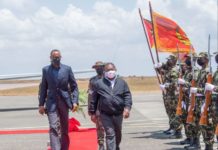PRESS RELEASE
· 22 April 1995-22 April 2015: 20 years since the massacre of the internally displaced persons in the Kibeho camp by RPF.
· 22 April 1997-22 April 2015: 18 years since the Kasese refugees’massacre by RPF
How long will these massacres remain unpunished?
Since the 1995 Kibeho massacre, 22 April has become an unforgettable mourning day in the memory of Rwandans. Indeed, though the world is somewhat indifferent before unspeakable abuses against millions of innocent civilians committed by the RPF since October 1, 1990 up to date, we will never forget the slaughterof 8,000 internally displaced persons in Kibeho camp (then Gikongoro prefecture) on 22 April 1995 by the Rwandan Patriotic Army (then RPA ) in the presence of UN blue helmets. According to the testimony of corporal Paul Jordan, an Australian soldier then serving as part of the United Nations Assistance Mission for Rwanda who witnessed this massacre, “{The} camp had been surrounded by two battalions of Tutsi troops from the Rwandan Patriotic Army (RPA), which regarded it as a sanctuary for Hutu perpetrators of the 1994 genocide. In the ethnic slaughter that followed, the RPA killed some 4000 of the camp’s inhabitants.”
In much the same way, we cannot forget the horror of the bloodshed suffered by Hutu refugees in the ex-Zaire (now DRC) who suffered a two- year-horrific manhunt by the very RPF army during the period between 1996 and 1997. Refugees were helplessly hunted down and killed in many areas of the DRC rainy forests over a distance of 2,500km, the most notorious places being Kashusha, Walikare, Kasese, Tingi Tingi, Ubundu, Mbandaka, to quote but some. As is often pointed out by many reliable sources the best known of which being the UN Mapping Exercise Report issued on October 1, 2010, such attacks are a violation of international humanitarian law and amount to crimes against humanity, genocide and war crimes.
Kasese massacre took place on 22 April 1997 when thousands of refugees, among whom mothers with their babies strapped to their backs, children, the elderly and the sick, after having been stopped from fleeing further than Kisangani, were compelled to go backwards and head for Ubundu along the railway. After an approximate 8-hour-walk blotted by numerous casualties under the control of RPA, away from inhabited areas and therefore away from any foreign witness, the RPA made sure that they were worn out and suggested that they could sit down, have a break and prepare something to eat . During the mock break, the huge crowd of helpless refugees were surrounded, fired and bombed by RPA battalions. After the killings, most corpses were piled up and burned while others ended up in mass graves. This Kasese carnage took away the lives of more than 30,000 refugees. According to witnesses, the horrors of the massacre were too cruel to describe.
Two decades later, above mentioned atrocities are still unpunished, the world is silent. How long can this situation be ignored? This is a challenge to the international community, the African Union, the European Union and the United Nations.
For, it is only through equal and transparent justice that the Rwandan people can reach reconciliation and ensure that all victims have equal right to memory.
Done at Lyon, 22nd April, 2015
FDU- National Movement- INKUBIRI
Eugene NDAHAYO, Chairperson































































